Open-graded friction course(OGFC)mixtures have been widely used in asphalt pavement surfaces due to traffic safety in rainy conditions and environmental benefits[1-2].Despite the functionality benefits, engineering practices have found that the application of OGFC mixtures in seasonally frozen regions faces the challenges of freeze-thaw(FT)-induced damages[3-4].Nineteen northern states in the USA have discontinued the use of OGFC mixtures due to FT-induced distress[5].In the Netherlands, the serious raveling of OGFC mixtures has been found at the Dutch primary road network subjected to a period of FT weather[6].In Japan, OGFC pavements with a service life of less than 7 years were mainly located in northern regions, where FT is relatively frequent[7-8].
However, there is no standard testing procedure focused on the FT resistance in the current design method and performance testing of OGFCs.The only testing related to FT cycles is the Lottman moisture susceptibility test proposed by AASHTO T-283.Considering that only one FT cycle in the test is quite different from the climate condition in winter, Mallick et al.[9] recommended a modi ed version of the AASHTO T-283 procedure.The National Asphalt Pavement Association also recommended modifying the Lottman method by replacing one FT cycle with five cycles[10].However, Watson et al.[11] reported no significant difference in the tensile strength when one, three, and
ed version of the AASHTO T-283 procedure.The National Asphalt Pavement Association also recommended modifying the Lottman method by replacing one FT cycle with five cycles[10].However, Watson et al.[11] reported no significant difference in the tensile strength when one, three, and  ve FT cycles were used in the moisture-conditioning procedure.Furthermore, the testing conditions for the evaluation of OGFC moisture/FT-induced damages are confusing.Moreover, the FT cycle tests were mainly conducted on fully saturated OGFC mixtures.Nevertheless, according to Chen et al.[12], internal air voids in the OGFC mixture are not completely filled with water even in the seepage process.After the end of the seepage, the content of pore water will be lower owing to the excellent drainage and evaporation of OGFC mixtures.Therefore, FT cycles in winter mainly occur in unsaturated OGFC pavements rather than water fully saturated OGFCs.Thus, investigating the effects of saturation degrees(SDs)on OGFC’s expansion and contraction during FT cycles is essential.Moreover, the mechanical performance, especially the raveling resistance of unsaturated OGFCs after FT cycles, needs to be carefully examined.
ve FT cycles were used in the moisture-conditioning procedure.Furthermore, the testing conditions for the evaluation of OGFC moisture/FT-induced damages are confusing.Moreover, the FT cycle tests were mainly conducted on fully saturated OGFC mixtures.Nevertheless, according to Chen et al.[12], internal air voids in the OGFC mixture are not completely filled with water even in the seepage process.After the end of the seepage, the content of pore water will be lower owing to the excellent drainage and evaporation of OGFC mixtures.Therefore, FT cycles in winter mainly occur in unsaturated OGFC pavements rather than water fully saturated OGFCs.Thus, investigating the effects of saturation degrees(SDs)on OGFC’s expansion and contraction during FT cycles is essential.Moreover, the mechanical performance, especially the raveling resistance of unsaturated OGFCs after FT cycles, needs to be carefully examined.
In this study, an experimental method was proposed to control the SD in an OGFC specimen.The expansion and contraction of the OGFC with different SDs during FT cycles were measured using strain gauges.The effects of the SD, air void content(AVC), and number of FT cycles on the volumetric deformation were evaluated.The influence of the SD on the degradation of the anti-raveling performance was also investigated.
1 Testing Materials
OGFCs with a nominal maximum aggregate size of 13.2 mm(OGFC-13)with three AVCs were prepared using crushed basalt aggregate, limestone filler, and modified asphalt.The properties of the modified asphalt prepared by 90# base asphalt and 5.4% styrene-butadiene-styrene were measured and are listed in Tab.1.
Tab.1 Basic properties of modified asphalt

Softeningpoint/℃Penetrationat25℃/0.1mmDuctilityat5℃/cmViscosityat60℃/(Pa·s AfterRTFOTMassloss/%Penetrationratioat25℃Ductilityat5℃/cm90.563341450080.0015328
Three skeleton gradations used in OGFC-13 were developed based on the theory of aggregate packing(ASTM D7064/D7064M-08), as shown in Tab.2.The optimum asphalt content(AC)for each gradation determined based on the Cantabro loss tests and binder draindown tests are also listed in Tab.2.The AVC of the compacted OGFC mixture was determined after measuring the bulk specific gravity of the compacted specimen and the theoretical maximum specific gravity in accordance with AASHTO T 275 and AASHTO T 209, respectively.Tab.2 presents the AVCs for each gradation used in OGFC-13.
Tab.2 Gradations used in OGFC-13 with three AVCs

No.Masspercentage/%d=16mmd=13.2mmd=9.5mmd=4.75mmd=2.36mmd=1.18mmd=0.6mmd=0.3mmd=0.15mmd=0.075mmAVC/%AC/%110096.565.030.520.014.710.37.36.04.920.75.0210097.170.026.917.0011.88.46.15.04.124.94.7310096.363.025.716.012.08.76.45.44.530.84.4 Note dispassingsievesize.
2 Laboratory Testing Methods
2.1 Control methods for the SD
The compacted OGFC-13 Marshall specimens with six SDs(e.g., 0, 10%, 30%, 50%, 70%, and 100%)were prepared in the laboratory.The preparation procedure includes the following steps:
1)Put the compacted OGFC-13 Marshall specimen into an elastic plastic balloon.Cut off the opening of the balloon to seal the bottom and side of the specimen.The weight of the dry mass(m0)was measured.The sealed specimen was fully immersed in water and set into the vacuum machine with a pressure of-97.5 kPa for 10 min.
2)Take the fully saturated OGFC specimen out of the vacuum machine and measure the mass of the saturated specimen(m1).The mass of water in the saturated OGFC mixture was determined to be m1-m0.
3)Pour the water out of the OGFC-13 specimen.The sealed wet specimen was then placed in the oven at 45 ℃ until the constant weight of the specimen was achieved.The water with a mass of S(S=m1-m0)was poured into the dry specimen from the unsealed top surface to achieve the SD of mass S.
2.2 Expansion and contraction testing during FT cycles
A strain gauge method was developed to automatically measure the expansion and contraction deformation of the OGFC specimen surface.The testing procedure of the strain gauge method includes the following steps:
1)The BX 120-50AA strain gauges, each with a measured length of 5 cm(see Fig.1(a)), were stuck on the surface of the sealed OGFC specimen with the SD of mass S.Considering the heterogeneity and anisotropy of the OGFC mixture, five gauges were used to measure the surface strain at different positions, as shown in Fig.1(b).No.A gauge was stuck on the top surface of the OGFC specimen.Three parallel ones stuck on the side with an interval of 2 cm were used to measure the hoop deformation at three heights, i.e., No.B, No.C, and No.D gauges, as shown in Fig.1(b).No.B gauge was 1 cm from the top surface.The fifth gauge(No.E)was stuck vertically on the side to measure the vertical deformation.
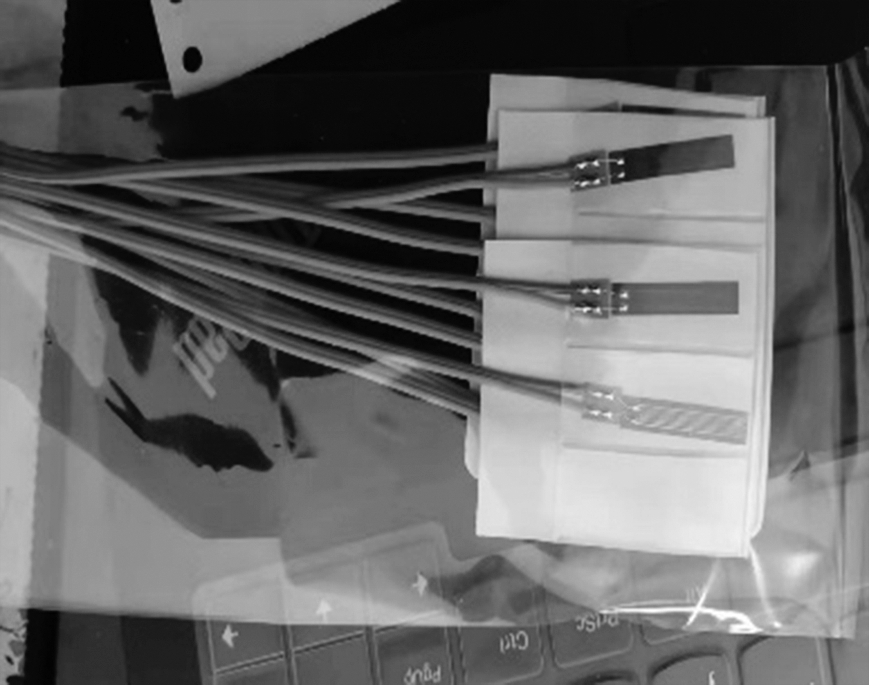
(a)
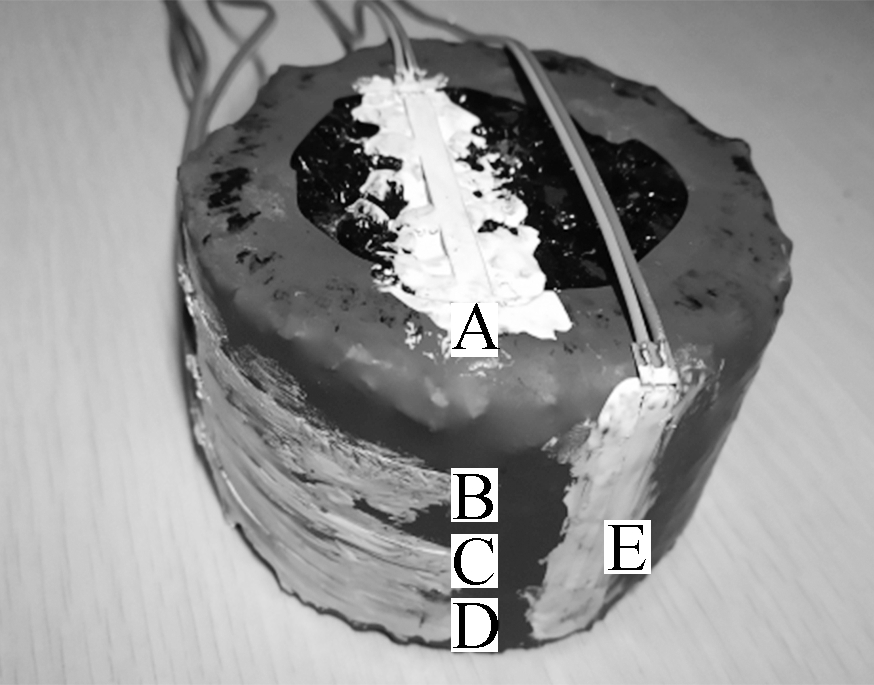
(b)

(c)
Fig.1 Appearance of the equipment and specimen.(a)Strain gauges;(b)Sealed OGFC-13 specimen with five strain gauges;(c)DH-3818 static strain tester
2)The five gauges were connected to the DH-3818 static strain tester, as shown in Fig.1(c).It is produced by Jinan Jiuwang, China.The 5 ℃ OGFC-13 specimen with the strain gauges was placed into the freezer at-15 ℃ for 480 min freezing and then the box at 10 ℃ for 480 min melting.Particularly, the gauges stuck on the OGFC specimen contracted or expanded when the temperature changes, which resulted in the inaccuracy of the measurement deformation of the OGFC specimen.To compensate for the temperature deformation of strain gauges, a free strain gauge was subjected to FT to measure the temperature deformation of the strain gauges.The strain of the OGFC specimen exposed to FT is the sum of the measured strain on the OGFC surface and the temperature deformation of the free strain gauge.
2.3 Cantabro loss test
The Cantabro loss test was used to determine the abrasion mass loss of the Marshall specimens utilizing the Los Angeles abrasion machine.The percent of mass loss(Cantabro loss)due to the breakdown of the compacted specimens was calculated as
(1)
where CL is the Cantabro loss; C and D are the initial and final mass of the test specimen, respectively.The Cantabro tests were conducted on OGFC-13 before and after the FT cycles to indicate the degradation of the mechanical performance.
3 Analysis of Influencing Factors
3.1 SD
OGFC-13 specimens with an AVC of 20.4% and six SDs(e.g., 0, 10%, 30%, 50%, 70%, and 100%)were prepared.The strain of the specimen surface was measured during 480 min freezing, as shown in Fig.2.In the figure, the SD shows a great influence on the volume change of the porous asphalt mixture exposed to freezing.The dry porous asphalt mixture contracted during freezing, whereas the fully saturated mixture first contracted and then expanded.The porous asphalt mixture with the medium SD had a volume change of contraction→expansion→contraction during the whole freezing process.In addition, although the general trend of contraction or expansion is the same, the strain, particularly the expansion strain, is quite different for different measured positions of the saturated mixture.The reason is that the distribution of void water is inhomogeneous.The internal structure with more void water produces more expansion due to ice formation.
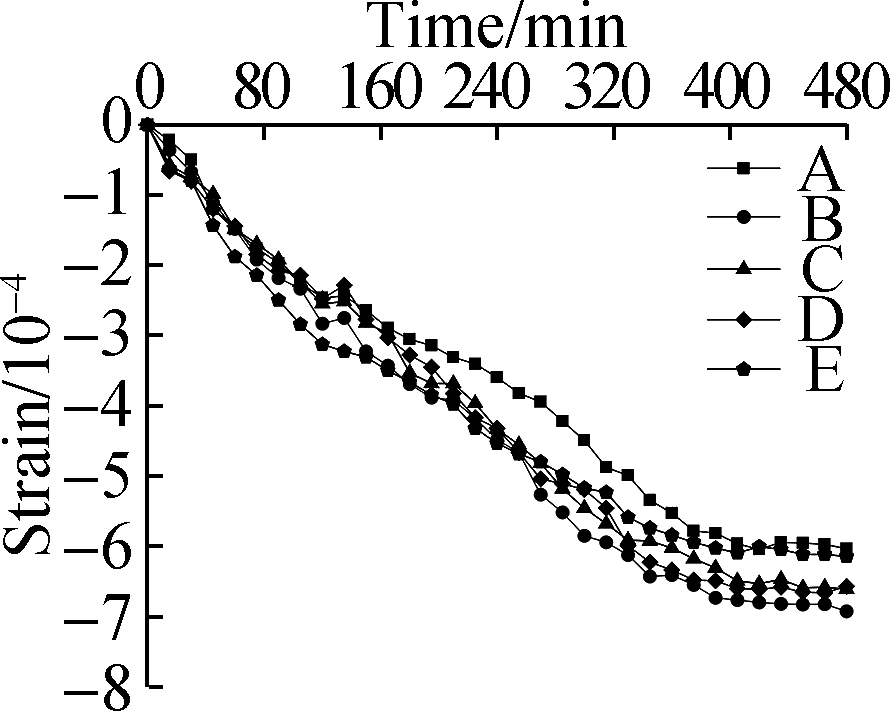
(a)
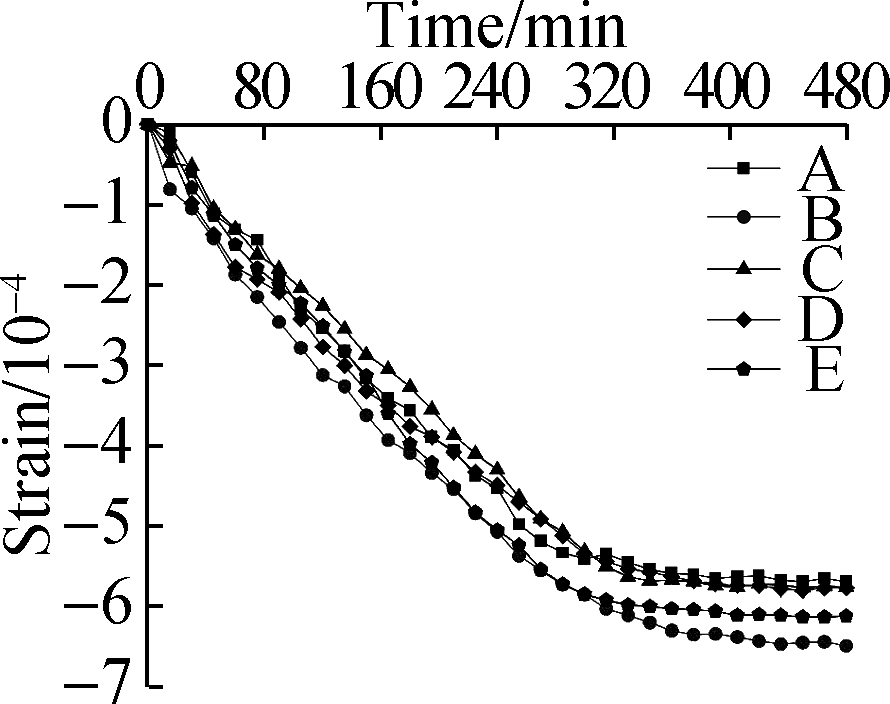
(b)
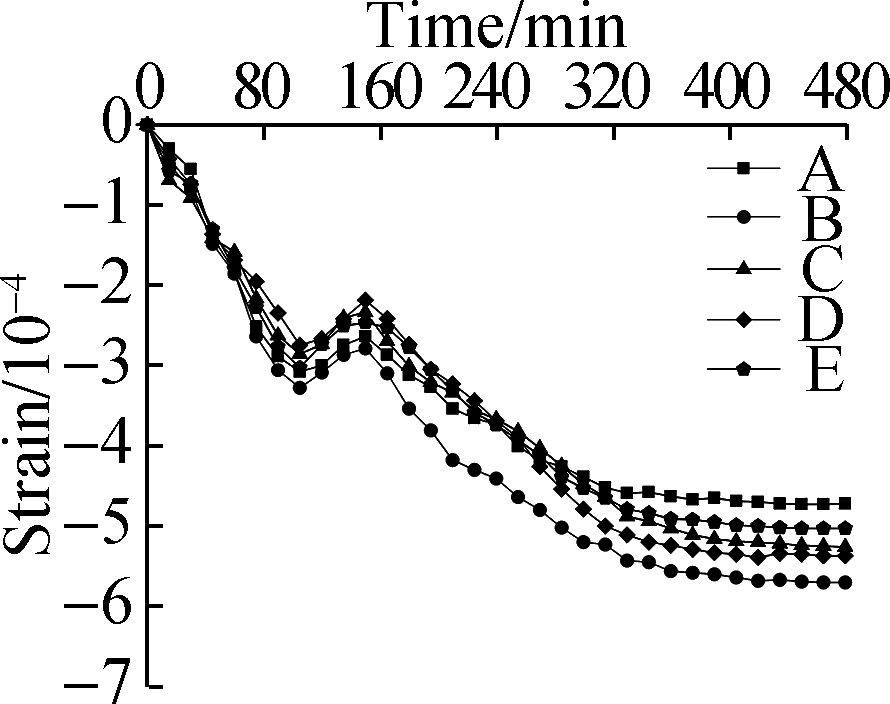
(c)
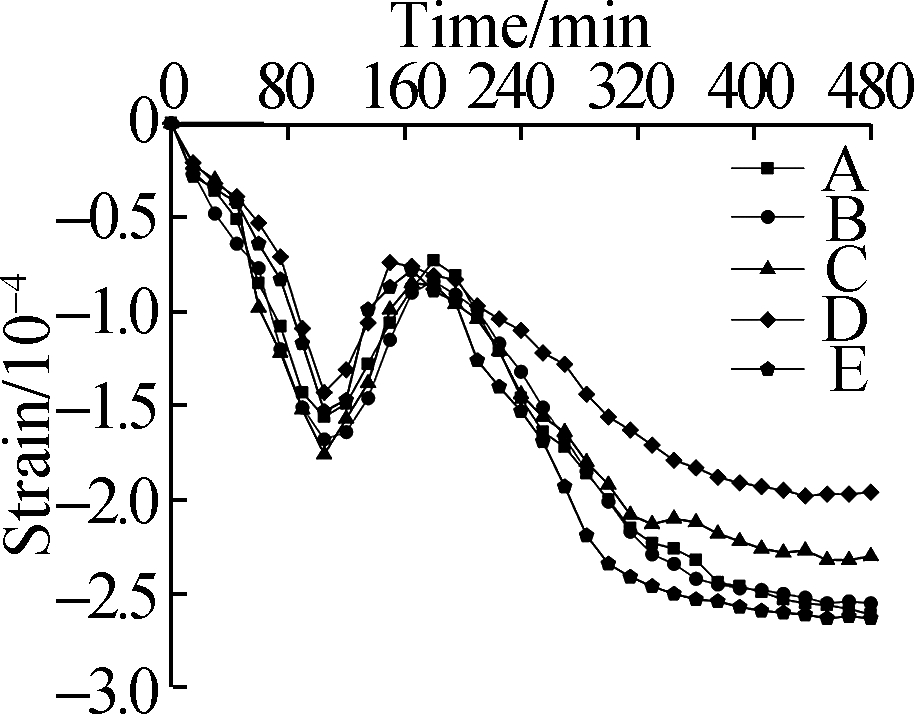
(d)
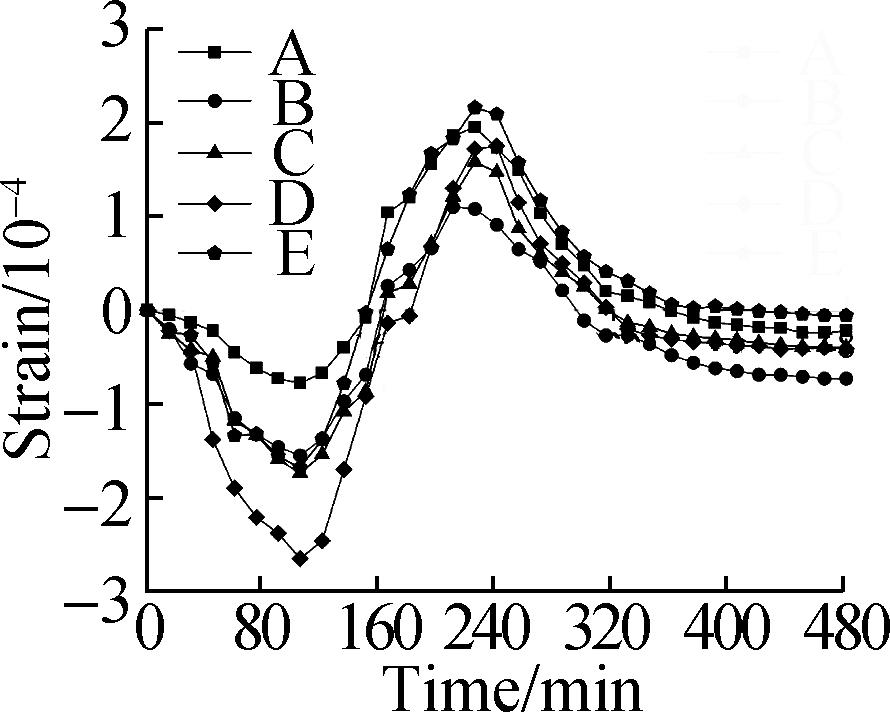
(e)
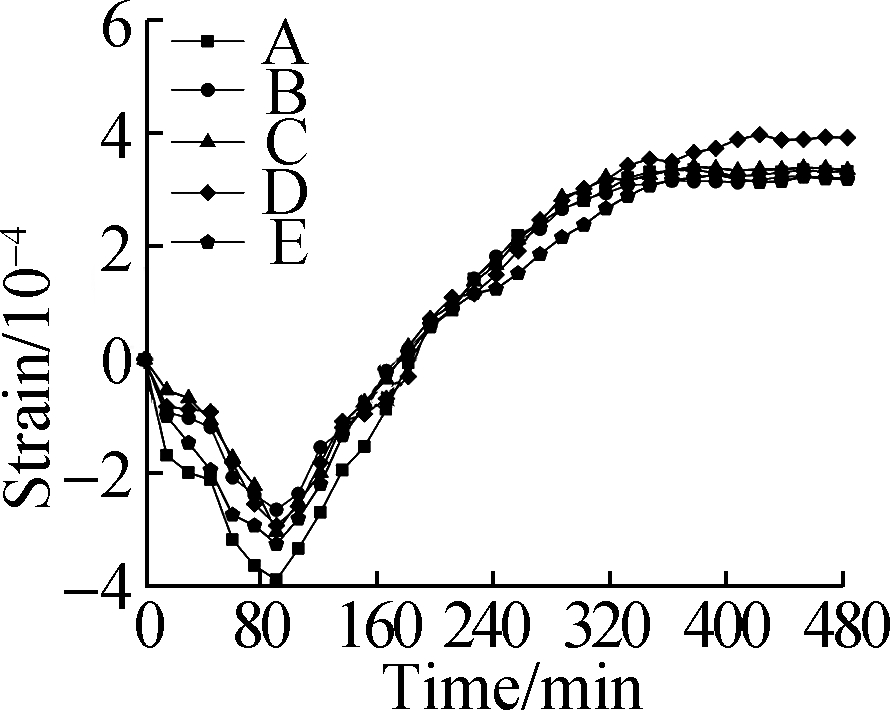
(f)
Fig.2 Expansion and contraction of freezing OGFC-13.(a)SD of 0;(b)SD of 10%;(c)SD of 30%;(d)SD of 50%;(e)SD of 70%;(f)SD of 100%
The frozen OGFC-13 specimen was placed into the box at 5 ℃ for 6 h melting.The residual strain after one FT cycle is presented in Fig.3.In general, OGFC-13 had a residual contraction strain for SD less than 70%, whereas OGFC-13 with an SD of more than 70% produced a residual expansion strain.Moreover, with the increasing SD, the residual shrinkage strain slowly decreased, and the residual expansion strain rapidly increased.In addition, the dry OGFC-13 had a residual contraction strain of less than 63×10-6 after one FT cycle, whereas the fully saturated OGFC-13 had a residual expansion strain as high as 128×10-6.These findings clearly indicate that the SD has a great influence on the residual strain after FT cycles.

Fig.3 Residual strain of OGFC-13 with different SDs
Fig.4 shows the Cantabro mass loss of OGFC-13 with six SDs before and after eight FT cycles.The results show that the mass loss of the OGFC exposed to eight FT cycles had a steady growth from 7.4% to 13.7%, with the increase in the SD from 0 to 50%.While the SD increased from 50% to 100%, the mass loss rapidly increased from 13.7% to 24.8%.This finding indicates that the increase in SD, especially from medium saturation to 100%, will greatly reduce the anti-raveling performance of the OGFC.Moreover, as shown in Fig.4, the mass loss of OGFC-13 with SDs of 70% and 100% is 21.6% and 24.8%, respectively, which are more than the allowed maximum mass loss of 15% in China.This finding indicates that the combination of FT cycles and high content of pore water has a significant negative effect on the anti-raveling performance of the OGFC pavement.OGFCs cannot be used in cold climate regions with frequent FT and rain/snow events.
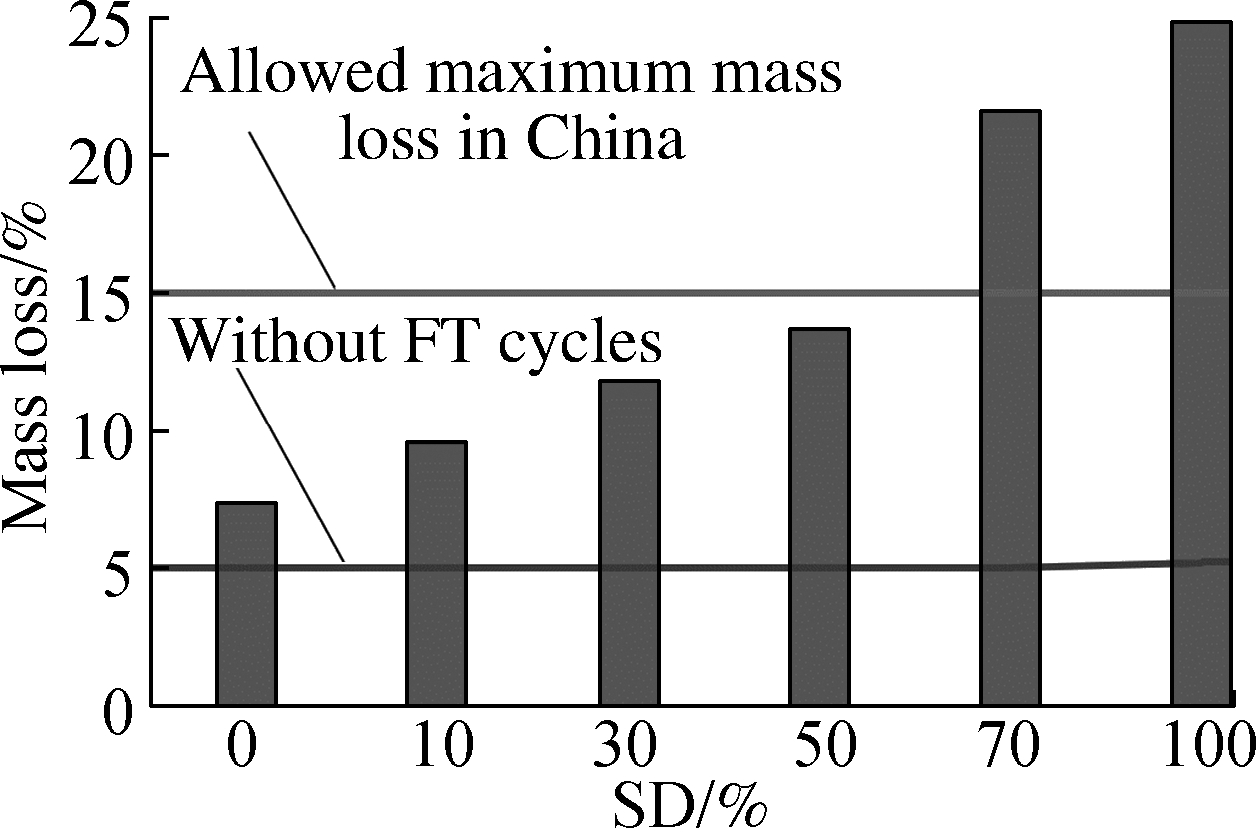
Fig.4 Measured Cantabro loss of OGFC-13
3.2 AVC
The volume change of OGFC-13 with AVCs of 20.7%, 24.9%, and 30.8% exposed to freezing was measured using strain gauges.The average value of the five measured strains by the five strain gauges was calculated and considered the volumetric strain(VS)of the whole OGFC specimen.Fig.5 presents the VS of the freezing OGFC-13 with three AVCs and four SDs(e.g., 0, 30%, 70%, and 100%).For the dry and 30% SD OGFC-13, the shrinkage strain increased with the increase in the AVC.The reason is that the internal air voids are conducive to the overall contraction of the freezing OGFC mixture.
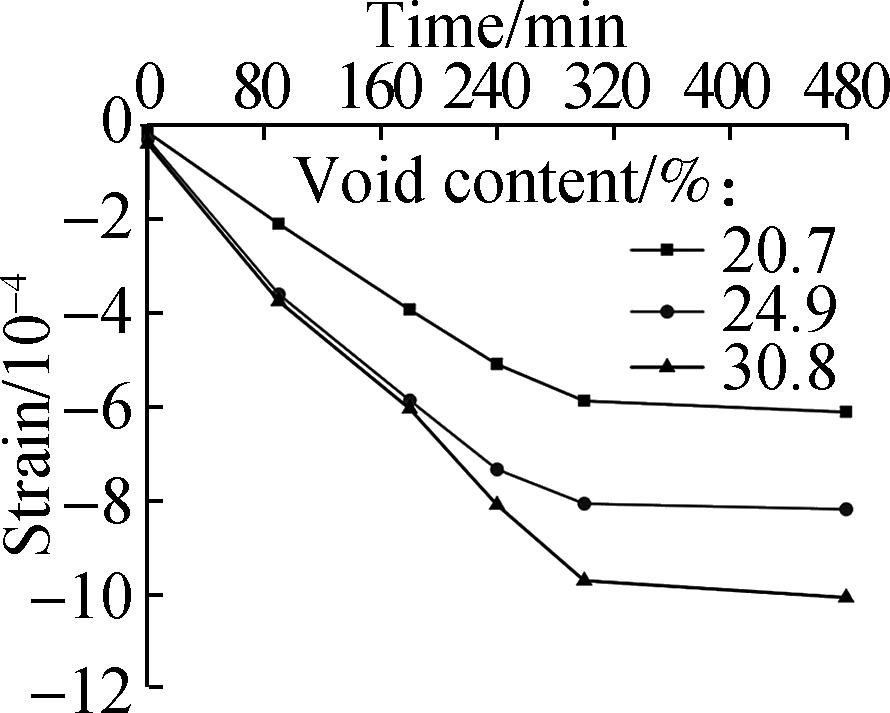
(a)
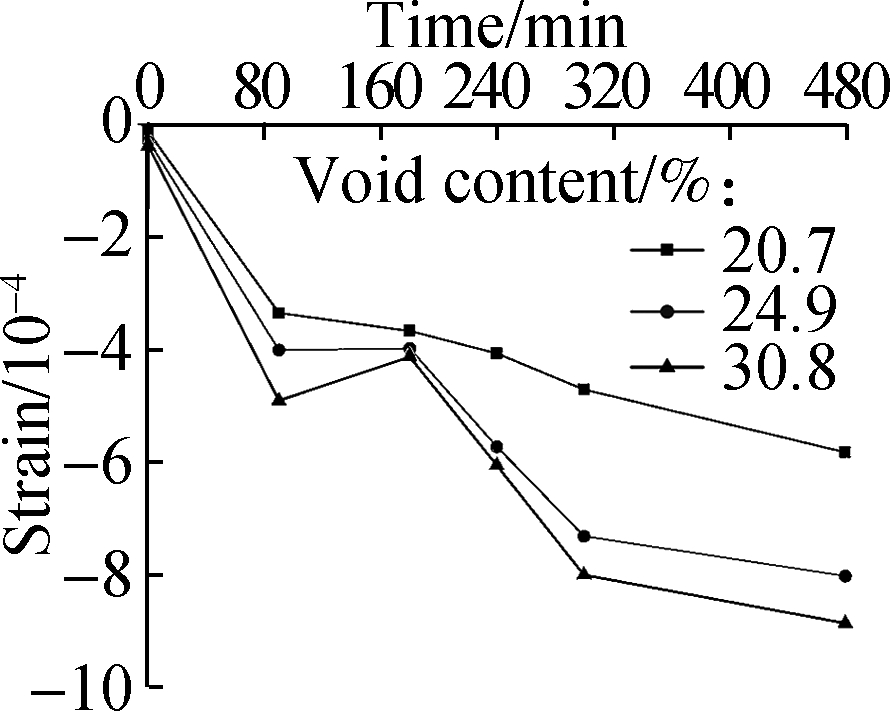
(b)

(c)
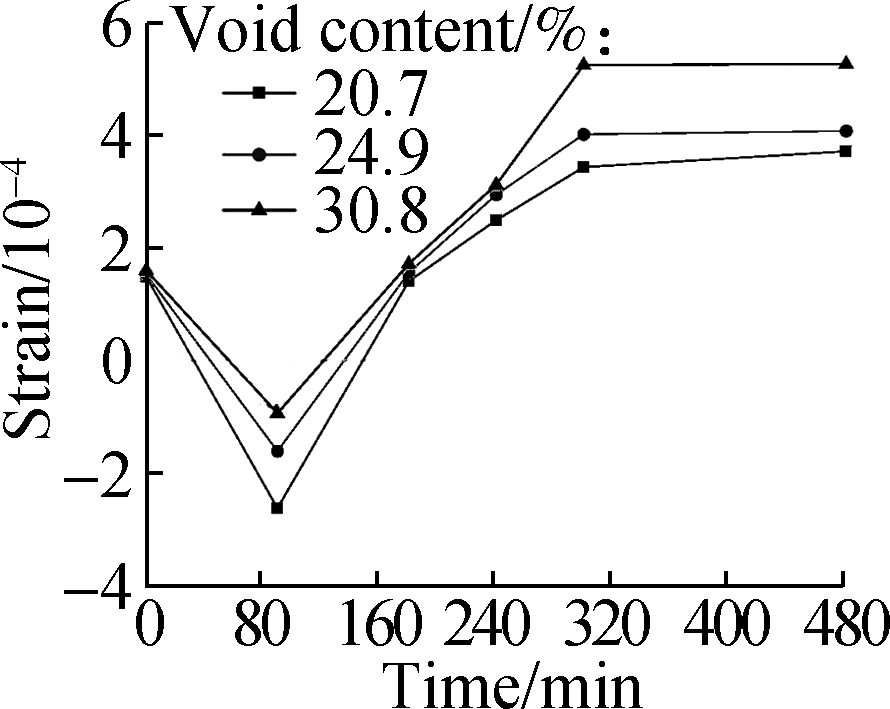
(d)
Fig.5 Measured strain of OGFC-13 with three AVCs.(a)SD of 0%;(b)SD of 30%;(c)SD of 70%;(d)SD of 100%
However, for the OGFC-13 with SDs of 70% and 100%, OGFC-13 with a higher AVC has less contraction from 0 to 100 min.This condition is caused by the higher specific heat capacity of void water compared with mineral aggregates.Hence, sufficient pore water is beneficial for resisting the low temperature shrinkage of the freezing OGFC mixture.Nevertheless, as shown in Figs.5(c)and(d), the OGFC-13 mixture with a higher AVC has more expansion strain at the middle and end stages of freezing.Therefore, for the OGFC with low SDs, the decrease in the void content can effectively reduce the low temperature shrinkage.Conversely, for the OGFC with high SDs, the lower void content produced more temperature shrinkage at the beginning of freezing and less expansion at the end of freezing.
Fig.6 presents the residual strain of OGFC-13 with three AVCs and four SDs(e.g., 0, 30%, 70%, and 100%)after one FT cycle.For the low saturation that produces temperature shrinkage during the whole freezing, the residual shrinkage of OGFC-13 exposed to one FT cycle decreased with the decrease in the AVC.For the high saturation that produced expansion at the end of freezing, the residual expansion also decreased with the decrease in the AVC.This finding clearly shows that a low AVC can effectively reduce the residual strain of the OGFC exposed to the FT cycle.

Fig.6 Residual strain of OGFC-13 after one FT cycle
Fig.7 shows the mass loss of OGFC-13 after eight FT cycles with three AVCs and four SDs.For the dry OGFC-13, the mass loss decreased from 14.1% to 7.2%, as the void content decreased from 30.8% to 20.7%.Moreover, at the same SD in OGFC-13, the mass loss decreased with the decrease in AVC.This finding clearly shows that the decrease in air voids can reduce the mass loss of the OGFC exposed to FT cycles at the same SD.By contrast, for the OGFC-13 with void contents of 20.7%, 24.9%, and 30.8%, the mass loss decreased by 29.5%, 30.7%, and 32.4% as the SD decreased from 100% to 0.This finding further proves that decreasing SD is effective in reducing the FT damage of the OGFC mixture.In addition, as shown in Fig.7, the effect of SD on the OGFC FT damage is more than that of AVC on the OGFC FT damage.
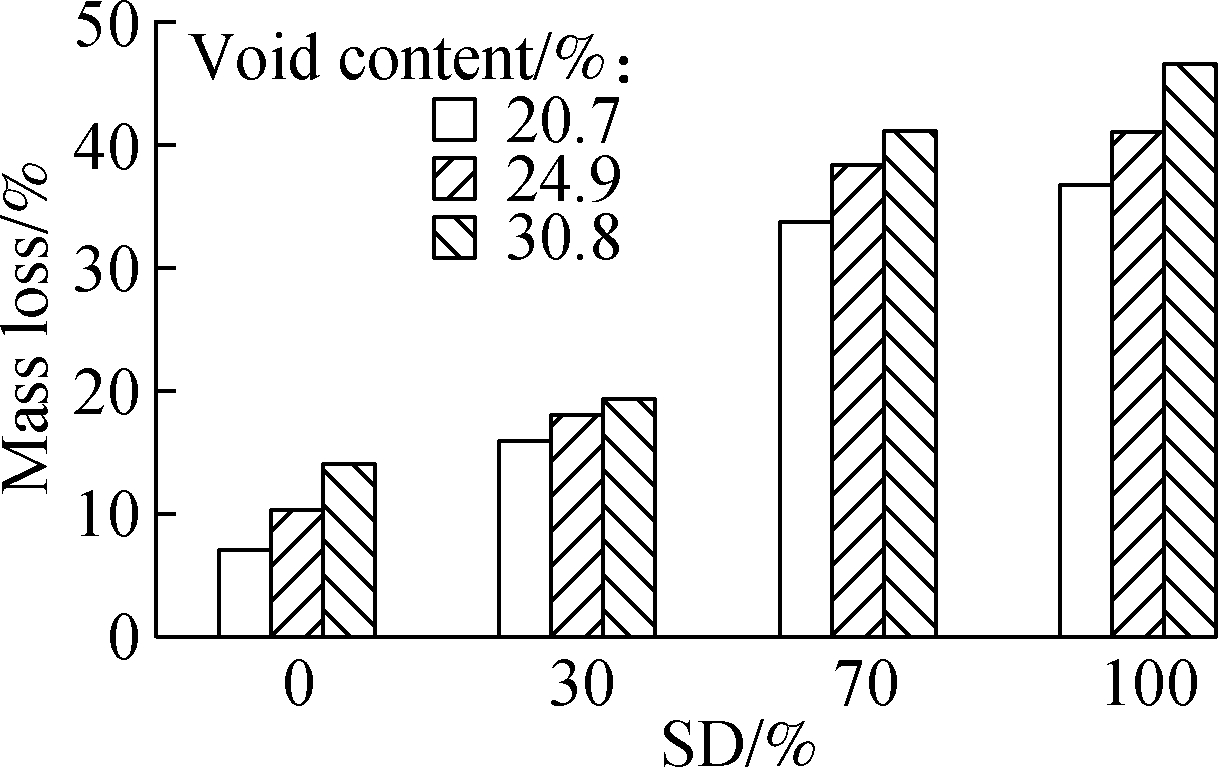
Fig.7 Cantabro mass loss of OGFC-13 after eight FT cycles
3.3 Number of FT cycles
The fully saturated OGFC-13 specimen with an AVC of 20.4% was subjected to eight FT cycles.The surface strain of the OGFC-13 during each FT cycle was measured and presented in Fig.8.The OGFC has a residual strain after each FT cycle because the expansion due to freezing was larger than the contraction due to ice melting.The residual expansion strain accumulates after a series of FT cycles.The accumulated residual expansions of the saturated OGFC-13 with an AVC of 20.4% were 77×10-6, 87×10-6, 89×10-6, 95×10-6, 102×10-6, 105×10-6, 107×10-6 after seven FT cycles.In addition, the difference ratio, the variation coefficients of the cumulative deformation at five measured positions on the OGFC-13 surface during eight freezing phases are 13.4%, 11.4%, 16.9%, 5.9%, 7.1%, 6.0%, 6.4%, and 4.7%, as shown in Fig.9.This finding means that, in general, the difference of the measured strain among the five gauges decreases as the number of FT cycles increases.This proves that the FT cycles reduce the internal stress concentration of the mixture exposed to FT cycles and make the mixture more uniform via expansion or contraction.

(a)

(b)
Fig.8 Measured strain of the fully saturated OGFC-13 during each freezing process.(a)1st to 4th FT cycle;(b)5th to 8th FT cycle
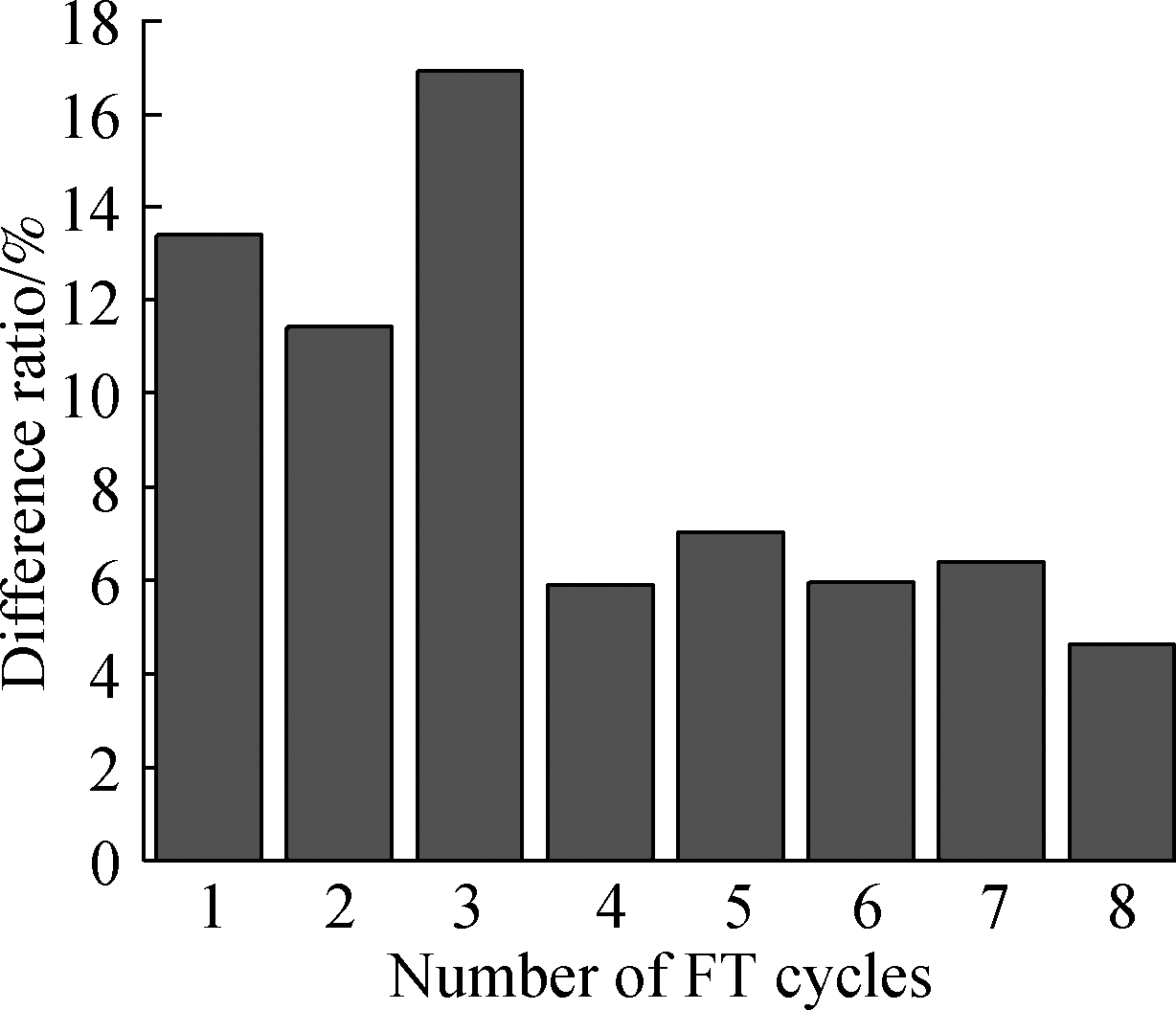
Fig.9 Difference ratio of the frost-heave strain measured at five positions of the OGFC-13 specimen after each FT cycle
4 Conclusions
1)The dry OGFC mixture contracts during freezing, whereas the saturated OGFC first contracts and then expands.The freezing OGFC mixture with medium saturation has a volume change of contraction→expansion→contraction.
2)For the OGFC with a low SD, the decrease in the void content can effectively reduce the low temperature shrinkage.Conversely, for the OGFC with high SDs, the lower void content produces more temperature shrinkage at the beginning of freezing and less expansion at the end of freezing.
3)The expansion due to freezing is larger than the contraction due to ice melting, which causes residual expansion after each FT cycle.The accumulated residual expansion increases with the increase in the number of FT cycles.FT cycles reduce the internal stress concentration of the mixture and make the mixture more uniform through the expansion or contraction of the inside structure.
4)An evident mechanical degradation in raveling resistance(Cantabro mass loss)is observed for the OGFC mixture due to the FT cycles.The decrease in SDs and AVCs can effectively improve the raveling resistance of OGFCs exposed to FT cycles.
[1] Nicholls J.Review of UK porous asphalt trials[M].London, UK: Transport Research Laboratory, 1997.
[2] Putman B J.Evaluation of open-graded friction courses: Construction, maintenance, and performance, FHWA-SC-12-04[R].South Carolina, USA: South Carolina Department of Transportation, 2012.
[3] Fay L, Akin M.Snow and ice control on porous and permeable pavements: A literature review and state of the practice[C]//Transportation Research Board Meeting.2014:1-15.
[4] Yildirim Y, Dossey T, Fults K , et al.Winter maintenance issues associated with new generation open-graded friction courses, FHWA/TX-08/0-4834-2[R].Austin, TX, USA:The University of Texas at Austin, 2007.
[5] Hernandez-Saenz M A, Caro S,Arámbula-Mercado E, et al.Mix design, performance and maintenance of Permeable Friction Courses(PFC)in the United States: State of the Art[J].Construction and Building Materials, 2016, 111: 358-367.DOI:10.1016/j.conbuildmat.2016.02.053.
[6] Mohan S A.Winter damage of porous asphalt: Case study using a meso-mechanics based tool for lifetime optimization of PA[D].Delft, the Netherlands: Delft University of Technology, 2010.
[7] Zhang Z W, Sha A M, Liu X, et al.State-of-the-art of porous asphalt pavement: Experience and considerations of mixture design[J].Construction and Building Materials, 2020, 262: 119998.DOI:10.1016/j.conbuildmat.2020.119998.
[8] Takahashi S.Comprehensive study on the porous asphalt effects on expressways in Japan: Based on field data analysis in the last decade[J].Road Materials and Pavement Design, 2013, 14(2): 239-255.DOI:10.1080/14680629.2013.779298.
[9] Mallick R B, Kandhal P S, Cooley L A Jr, et al.Design, construction, and performance of new-generation open-graded friction courses[R].Reno, NV, USA: Association of Asphalt Paving Technologists, 2000.
[10] Kandhal P S.Design, construction and maintenance of open-graded asphalt friction courses[R].Greenbelt, MD, USA: National Asphalt Pavement Association, 2002.
[11] Watson D E, Cooley L A Jr, Ann Moore K, et al.Laboratory performance testing of open-graded friction course mixtures[J].Transportation Research Record: Journal of the Transportation Research Board, 2004, 1891(1): 40-47.DOI:10.3141/1891-06.
[12] Chen J, Yin X J, Wang H, et al.Directional distribution of three-dimensional connected voids in porous asphalt mixture and flow simulation of permeability anisotropy[J].International Journal of Pavement Engineering, 2020, 21(12): 1550-1562.DOI:10.1080/10298436.2018.1555330.